The worst thing is to run out of juice on your electronic devices while on a long backpacking trip. It’s dangerous to be without a phone in an emergency, but you may also want to charge up your other devices to enjoy yourself more fully at the end of a long day of hiking.
You need a solar charger specifically designed for backpacking so that your items always hold a charge. To make your decision even easier, this list of the best solar chargers for backpacking takes an objective look at what you’ll find on the market today.
If you want to know the best solar charger for backpacking without reading, we recommend the Ryno Tuff 21W.
Best Solar Chargers for Backpacking
- BigBlue 3 28W (Budget Buy)
- Goal Zero Nomad 20W
- Anker PowerPort Solar Lite 21W
- Powertraveller Falcon 40 Solar Panel (High End)
- Ryno-Tuff 21W (Top Pick)
- Sunjack 15W
Compare Top Backpacking Solar Chargers
| Product | Overall Score | Bottom Line | Price |
|---|---|---|---|
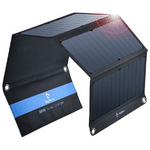
BigBlue3 28W | 80 | Best output for the price | Check Out on Amazon |
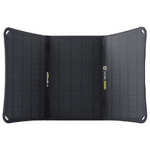
Goal Zero Nomad | 76 | Powerful output for a good price | Check Out on Amazon |
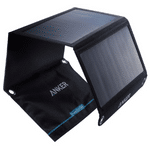
Anker PowerPort Solar | 82 | Best lightweight option | Check Out on Amazon |
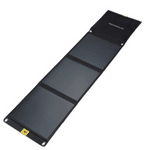
Powertraveller Falcon | 82 | Best option for charging laptops (DC outlet) | Check Out on Amazon |
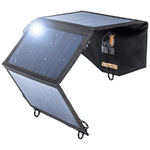
Ryno Tuff 21W | 86 | Best value for the money | Check Out on Amazon |
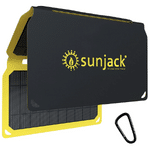
SunJack 15W | 84 | Best for beginners | Check Out on Amazon |
Detailed Analysis Of The Best Backpacking Solar Chargers
1. BigBlue 3 28W
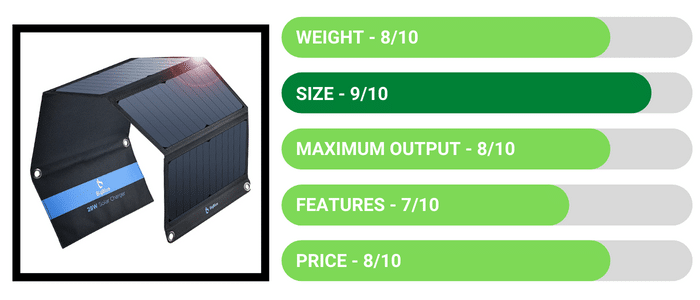

Overall Score: 80
Advantages
- Extremely lightweight
- Excellent features, including safe charging
- Weatherproof
Disadvantages
- Takes up more space in your pack
- Does not charge laptops
Weight
Backpackers must be conscious of every pound they put in their packs. Fortunately, the BigBlue 3 comes with great attention to making the solar charger as light as possible.
While the solar charger can soak up some serious sun and charge your devices, it’s still lightweight at just 20.5 ounces. You’ll have a powerhouse charger at a little over a single pound.
Size
Many backpackers like to keep their solar panels out on display during the day to soak up those prime afternoon UV rays.
However, you’ll want to ensure that your charger also fits in your pack when it’s not in use. The BigBlue is extremely compact, with folded dimensions 11.6 inches by 6.3 inches by 1.3 inches.
If you want the unfolded dimensions, you’ll be surprised at just how much surface area it has to capture the sunlight. Its unfolded size comes to 33.1 inches by 11.1 inches by 0.2 inches.
Maximum Output
One of the most important features of a solar charger is its maximum output. This determines just how many devices you’ll be able to charge and approximately how long it’ll take.
The BigBlue 3 has a maximum output of 5V/2.4A and a maximum current of 3 USB at 5V/4.8A. You’ll be able to charge multiple devices simultaneously with this 28W system.
Features
No solar charger is complete without taking a closer look at the features it promises to its users. This solar charger is great for those concerned about damaging their devices, as it has the protection you need.
It features safe charging with overcurrent, overheating, and even short-circuit protection for your devices.
You’ll also be pleased to know that it has one of the highest conversion rates of all solar chargers on the market today.
The solar panel portion of the charger converts 24 percent of solar power into free energy. Plus, the panels are constructed of PET polymer to protect them when the weather gets wet.
Keep in mind that this panel doesn’t store electricity and will not be able to charge a laptop or certain iPad devices.
Price
If you are out on the trail for quite some time, you’ll want to ensure that your phone is charged just in case of emergencies. Adding a solar charger to your pack is necessary, but will it break your budget?
The BigBlue 3 is a great investment and is relatively affordable for solar chargers. It’s an investment that will yield big returns later but won’t bankrupt you right now.
2. Goal Zero Nomad 20W
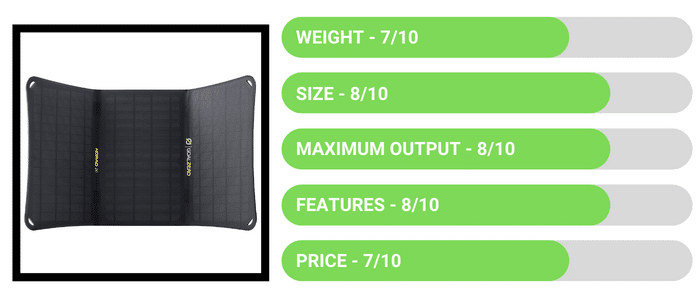
Overall Score: 76
Advantages
- Powerful maximum output
- Lengthy warranty
- Weatherproof
Disadvantages
- Heavier but takes up less space
- Expensive
Weight
Compared to the BigBlue 3, the Goal Zero Nomad will weigh you down just a little more. It’s not enough to make a huge dent in your pack, but every ounce matters when going on a long hike or extended trip.
This solar charger weighs 2.25 pounds which isn’t enough to slow you down yet, but it’s something to consider when trying to make the lightest backpack possible.
Size
While it’s a little heavier than some, it takes up less space in your backpack which can offset the inconvenience of a few extra ounces.
The folded dimensions of the solar charger are 11.5 inches by 7.4 inches by 1.25 inches. Even unfolded, it takes up less space with overall measurements of 11.5 inches by 21.75 inches by 0.75 inches.
Maximum Output
This 20W charger has a powerful output of 5V on the USB port, up to 2A or 10W max. It also has a solar port between 14V and 22V up to 1.3A or 20W maximum.
The mini solar port (which measures 2.5 mm) has a 6.5V output of up to 1.1A or 7W max.
Features
Like most solar chargers, the Goal Zero Nomad doesn’t hold the charge when exposed to the sun, so you’ll also likely want to invest in a portable recharger.
However, with this device, you can charge just about any item you want: headlamps, phones, tablets, USB devices, and power packs.
You don’t have to fret if you’re worried about how the solar charger will hold up.
It comes with a 12-month warranty to cover any manufacturer defects that impact your ability to charge your devices while on the trail.
Not to mention, it holds up well in all terrain and weather due to its weatherproof construction.
While you may be unable to charge up your devices on an overcast and rainy day, you don’t have to worry about ruining your investment in the Nomad chargers.
Price
The initial investment is the only downside to the Goal Zero Nomad 20W charger. You’ll have the power of a well-respected name brand in the industry, but you’ll have to pay for it.
It’s not the most budget-friendly device on the market. However, you’ll have this investment for years, so consider it a wise investment in your gear.
3. Anker PowerPort Solar Lite 21W
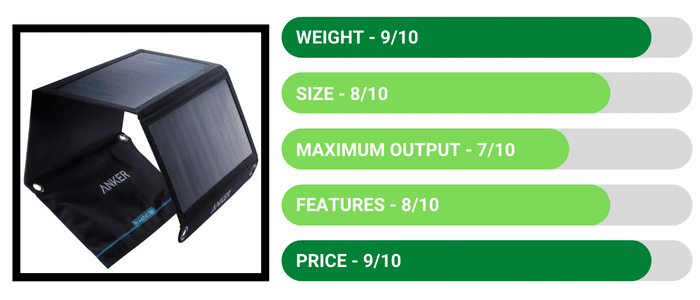
Overall Score: 82
Advantages
- Extremely lightweight
- Affordable
- Charges most phones
- Weatherproof
Disadvantages
- Lower maximum output
- Smaller surface area (unfolded)
Weight
If you’re concerned about how much the solar charger will weigh down your pack, all you need to do is look at the Anker PowerPort.
It’s one of the lightest models on the market, clocking in at under one pound. It’s just 14.7 ounces, but don’t let its light weight fool you. It still packs a great punch when it comes to output and features.
Size
For those concerned about how much space it’ll take up in their pack, there’s more good news about the Anker PowerPort.
Folded up, it takes up just 11.1 inches by 6.3 inches, making it smaller than the Goal Zero and more comparable to the BigBlue 3.
Unfolded, it has plenty of surface area to absorb the sunlight. You’ll be able to fix it to the outside of your backpack easily for charging on the go with dimensions of 26.4 inches by 11.1 inches opened.
Maximum Output
Like most solar chargers, you’ll have a better charging speed when it’s in direct sunlight. It has an output of up to 2.4 Amps with a maximum output charging speed of 3 Amps.
This’ll allow you to charge just about any device in no time. Remember that it may slow down if your panels aren’t directly located in the sunlight.
Overall, it’s a 21W device greater than some of the other leaders on the market.
Features
Just because this solar charger is affordable doesn’t mean that it lacks the features that most backpackers want.
The solar system on this charger is capable of 21.5 to 23.5 percent efficiency, and it can charge up to two devices simultaneously.
You’ll also love that the solar panels are made of industrial-strength PET polymer that can resist the wet weather while you’re on the trail.
Another important feature is that it can charge about any phone type. From iPhones to Samsung Galaxies, you won’t be disappointed with the output of this charger.
It can also charge several tablets, including the iPad Pro, Air 2, and the mini.
Price
If you’re looking for something affordable just to get started with your backpacking gear, then the Anker is the right fit.
It is one of the least expensive models on the market, but it still packs a powerful punch. Don’t worry about whether you can afford this one – it’s solidly at the low end of the price spectrum!
4. Powertraveller Falcon 40 Solar Panel
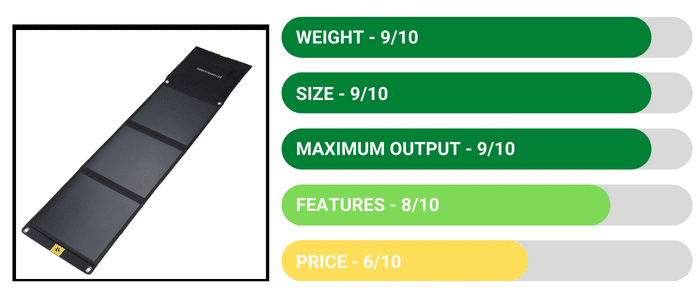

Overall Score: 82
Advantages
- Lightweight
- Large dimensions to convert more sunlight
- Can charge laptops with DC outlet
Disadvantages
- Expensive
Weight
When packing for an extended backpacking trip, you must ensure that every ounce in your backpack is packing the maximum punch.
The Powertraveller Falcon clocks in at just one pound, making it a great lightweight option. You’ll find that it fits conveniently into just about all packs.
Size
One of the areas where the Falcon 40 truly shines is its overall size. These panels are rather large, making them ideal for capturing as much sunlight as possible.
When unfolded, this solar charger’s overall dimensions are 11.42 inches by 47.24 inches by 0.12 inches.
However, you can also easily fold them to squeeze more room in your pack with dimensions of 11.5 inches by 11.5 inches by 0.43 inches.
Maximum Output
You can’t go wrong with the Falcon for those who want to charge their devices quickly and simultaneously. It features two USB sockets with a maximum of 5V and a 20V DC socket.
Unlike many other solar chargers, it also produces roughly 25 to 35 percent more power than conventional solar PV cells.
Features
One of the most important things to note about the Falcon 40 is that it can charge more than just smartphones and tablets.
With its DC port, you can also charge your laptop, which allows you to bring all of the comforts of home with you on your trip.
Laptops can charge in the DC port while you’ll still have 2 USB ports to charge simultaneously.
Like most of the best solar chargers for backpacking, you’ll find that the Powertraveller is made of monocrystalline cells that are durable no matter the weather.
They are both water and dustproof, meaning they’ll last you for the long haul.
Price
The only major downside to the Powertraveller Falcon 40 is its overall price. It’s not a budget-friendly option for those who are just getting into backpacking and have a lot of equipment to buy.
However, those who are serious about backpacking and want to charge laptops while on the go will want to invest in this solar charger.
5. Ryno Tuff 21W
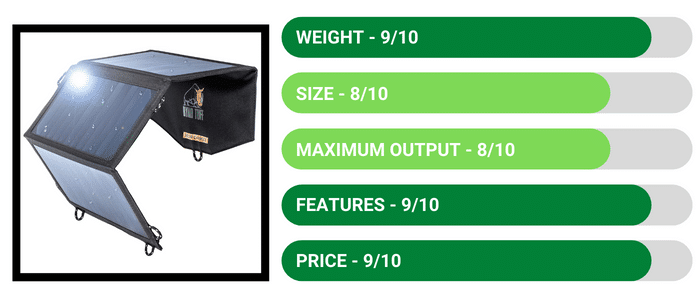

Overall Score: 86
Advantages
- Lightweight with lots of surface area
- Quick charging times
- Plant a tree with every purchase
- Lifetime warranty
Disadvantages
- Does not charge laptops
- A little expensive
Weight
You’ll love how lightweight the Ryno Tuff solar charger feels on your back.
It easily competes for one of the most lightweight options on this ranking of the best solar chargers, coming in at just 0.6 ounces over one pound.
A 16.6-ounce solar charger gives you the power you need without weighing you down.
Size
A small backpack doesn’t necessarily mean that you have to sacrifice power with portable solar chargers like this one from Ryno Tuff.
It takes up the least space when folded compared to other top-name brands. The overall folded dimensions are 5.9 inches by 11.8 inches by 0.79 inches for maximum compactness.
Even when unfolded, it’s still relatively small, which makes it easy to attach to the outside of your backpack using the included carabiner clips.
The unfolded measurements of the charger are 18.1 inches by 11.8 inches by 0.12 inches.
Maximum Output
One of the benefits of the Ryno Tuff solar charger is that it features more efficient solar power panels.
It offers 21W of solar power and allows you to charge two USB devices with a 2.4 Amp charge each time with a 5V system, even though it has a smaller footprint than some of the other chargers.
It’s important to note that you can charge a phone or tablet in as few as two hours, provided you have plenty of sun.
Features
The features of the Ryno Tuff solar charger are another homerun for this candidate for the top solar charger.
Designed for even the most rugged adventures, it’s constructed of waterproof PVC with 600D canvas to keep things safe.
Even better, it has a lifetime warranty that covers you if the charger stops working under normal conditions.
This solar charger is also one of the more efficient models today for backpackers.
The solar cells that make up the charger can convert up to 25 percent, allowing you to always have what you need to charge your devices via the USB ports.
If you’re concerned about the environment, one fun thing to note about the Ryno Tuff is that the company plants a tree with each purchase of these solar chargers.
Price
As far as price is concerned, you get a powerful charger that’s extremely lightweight and compact for a reasonable rate. It may not be the cheapest one on the market, but it certainly comes close.
It’s a great deal for something you’re sure to use time and again while backpacking, and it’ll still allow you to invest in more expensive equipment like a larger backpack.
6. SunJack 15W
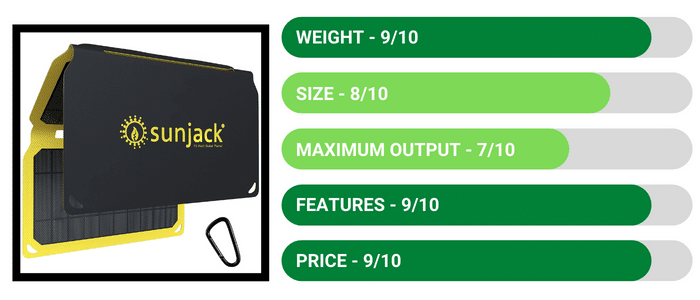
Overall Score: 84
Advantages
- Fairly lightweight
- Affordable
- 12-month warranty
Disadvantages
- Smaller surface area when unfolded
- Lower output
Weight
While it may not be the absolute lightest solar charger found here, the SunJack holds its own in this category. It weighs around 1.3 pounds, allowing it to work in even the heaviest packs.
Don’t discount it just because it’s lightweight, though. As you’ll see in the next sections, it also has powerful charging capabilities.
Size
The SunJack is one of the smallest solar chargers, especially when folded. It’s narrower than most, with a width of just 9.8 inches by 6.25 inches by 1.25 inches.
Unfolded, it’s still relatively small at 10 inches by 19.5 inches by 1 inch. If you’re worried about capturing the maximum amount of sunlight and converting it to solar energy, this is something to keep in mind.
Maximum Output
The good news is that the SunJack charger is great for just about any device short of a laptop. It can be used for smartphones, headphones, tablets, cameras, and smartwatches with USB-A and USB-C ports.
The USB-A port has a 5V/3A system, as does the USB-C. Remember that you’ll be using this system and will only get 15W maximum output.
They quickly point out that this charger can produce similar charging speeds to a standard wall outlet.
Features
You’ll be pleasantly surprised to learn that safety is the name of the game with this SunJack item.
The chip embedded in this solar charger helps you to receive the fastest and safest speed while protecting you from short-circuiting, overload, overheating, overcharging, and over-voltage.
It’ll also set itself to automatically restore for those hiking through shaded areas. The panels are made of monocrystalline, like all the best solar panels.
They have the best UV-ray permeability at 95 percent, whereas many others have only 80 percent. Plus, they are waterproof panels.
You don’t have to fret if you’re worried about how well this solar panel will hold up on the trail. They offer a 12-month hassle-free warranty to offer you the protection you need.
As a bonus, the warranty is handled by a US-based company in California for easier communication and contact.
Price
While it may not be the most powerful solar charger found here, it still gets the job done for many backpackers.
The SunJack 15W charger is an affordable solution that’ll fit in the smallest size space and won’t break your budget.
It’s the perfect solution for anyone who wants to invest in solid equipment without sacrificing quality.
Final Thoughts
As we end this roundup of the best solar chargers for backpacking, you should have a better idea of which one is the right fit for you.
Compare the output and the types of items you can charge with each one, how much it weighs in your pack, and what features matter most to you.
Based on our criteria, we found that the Ryno Tuff 21W has all the features you need without breaking the budget. You should consider adding this to your gear today!
